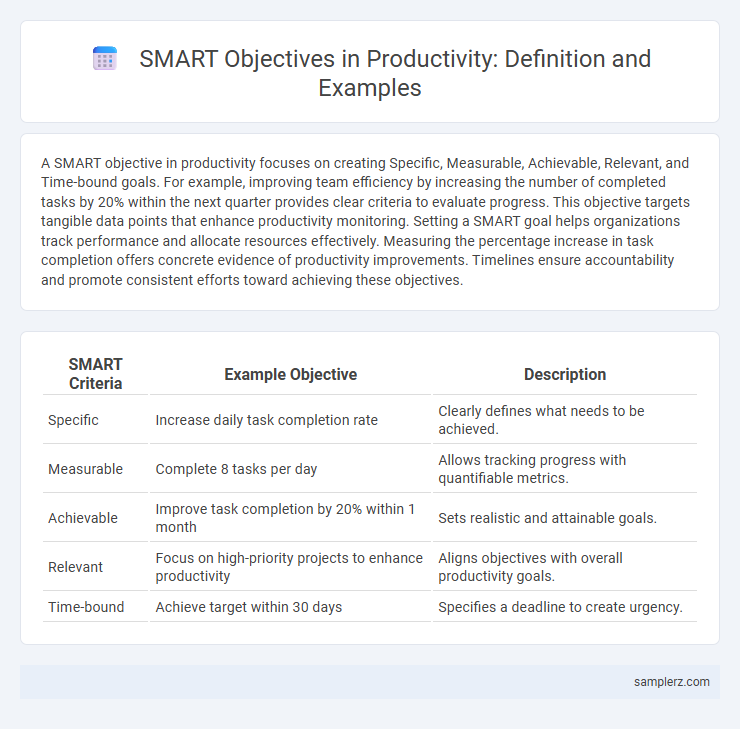A SMART objective in productivity focuses on creating Specific, Measurable, Achievable, Relevant, and Time-bound goals. For example, improving team efficiency by increasing the number of completed tasks by 20% within the next quarter provides clear criteria to evaluate progress. This objective targets tangible data points that enhance productivity monitoring. Setting a SMART goal helps organizations track performance and allocate resources effectively. Measuring the percentage increase in task completion offers concrete evidence of productivity improvements. Timelines ensure accountability and promote consistent efforts toward achieving these objectives.
Table of Comparison
| SMART Criteria | Example Objective | Description |
|---|---|---|
| Specific | Increase daily task completion rate | Clearly defines what needs to be achieved. |
| Measurable | Complete 8 tasks per day | Allows tracking progress with quantifiable metrics. |
| Achievable | Improve task completion by 20% within 1 month | Sets realistic and attainable goals. |
| Relevant | Focus on high-priority projects to enhance productivity | Aligns objectives with overall productivity goals. |
| Time-bound | Achieve target within 30 days | Specifies a deadline to create urgency. |
Understanding the SMART Framework in Objective Setting
SMART framework in objective setting emphasizes creating goals that are Specific, Measurable, Achievable, Relevant, and Time-bound, enhancing clarity and accountability. Understanding this framework boosts productivity by enabling individuals and teams to define clear targets and track progress effectively. Implementing SMART objectives fosters focused efforts and efficient resource allocation, driving consistent performance improvements.
Specific: Clarifying Your Objective’s Focus
A SMART objective is Specific when it clearly defines the desired outcome, pinpointing exactly what needs to be achieved. For example, instead of saying "improve sales," a specific goal would be "increase product X sales by 15% within the next quarter." This clarity helps maintain focus, measure progress accurately, and enhance productivity by eliminating ambiguity.
Measurable: Defining Quantitative Success Indicators
Setting SMART objectives in productivity involves defining measurable success indicators such as completing 20 tasks per week or increasing output by 15% within a month. Quantitative metrics like hours spent on focused work or number of projects delivered enable clear tracking of progress and performance. Establishing these measurable goals ensures objective evaluation and timely adjustments to improve efficiency.
Achievable: Ensuring Realistic and Attainable Goals
Setting achievable goals within the SMART framework involves analyzing resources, time constraints, and skill levels to establish objectives that are realistic and attainable. For instance, a project manager aiming to increase team output by 15% within three months ensures the target is grounded in current workforce capacity and ongoing projects. This approach maximizes productivity by preventing overcommitment and fostering sustainable progress.
Relevant: Aligning Objectives with Broader Priorities
Setting SMART objectives ensures productivity by aligning goals with broader priorities, making them Relevant to both individual roles and organizational missions. For example, a sales team objective to increase monthly revenue by 15% directly supports the company's overarching goal of market expansion. This alignment prioritizes effort on impactful tasks, enhancing focus and resource allocation.
Time-Bound: Setting Deadlines for Accountability
Setting deadlines under the Time-Bound criterion in SMART objectives enhances accountability and drives timely completion of tasks. For example, committing to finish a project report by March 31st provides a clear deadline that motivates consistent progress and prevents procrastination. This specific timeframe ensures measurable tracking of milestones and reinforces disciplined time management.
SMART Objective Example for Personal Productivity
A SMART objective for personal productivity might be: "Increase daily focused work sessions from one to three, each lasting 45 minutes, by the end of the month to improve task completion rate by 30%." This objective is Specific, Measurable, Achievable, Relevant, and Time-bound, enhancing efficiency and time management. Tracking progress through a productivity app ensures accountability and continuous improvement.
SMART Objective Example in Team Project Management
A SMART objective in team project management could be increasing project completion rates by 20% within six months by implementing weekly progress meetings and task tracking software. This goal is specific, measurable, achievable, relevant, and time-bound, ensuring all team members understand their responsibilities and deadlines. Using a clear SMART objective enhances accountability and streamlines collaboration, driving project success efficiently.
Crafting Effective SMART Objectives: Step-by-Step Guide
Crafting effective SMART objectives involves setting goals that are Specific, Measurable, Achievable, Relevant, and Time-bound to enhance productivity. For example, instead of saying "improve workflow," a SMART objective would be "reduce project completion time by 20% within three months by implementing automated task management tools." This clear focus drives accountability and enables tracking progress through quantifiable metrics aligned with organizational priorities.
Common Pitfalls to Avoid When Setting SMART Objectives
Setting SMART objectives often fails due to vague metrics, unrealistic timelines, or lack of specificity, which can hinder productivity and goal achievement. Common pitfalls include setting objectives that are too broad, not measurable, or unattainable within the given timeframe, causing loss of motivation and ineffective resource allocation. Ensuring objectives are clear, quantifiable, achievable, relevant, and time-bound prevents these issues and drives focused, productive outcomes.

example of SMART in objective Infographic
 samplerz.com
samplerz.com